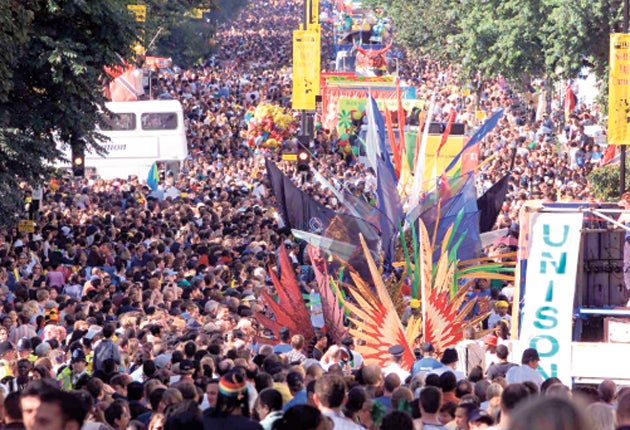The Timeline: The Notting Hill Carnival

Your support helps us to tell the story
From reproductive rights to climate change to Big Tech, The Independent is on the ground when the story is developing. Whether it's investigating the financials of Elon Musk's pro-Trump PAC or producing our latest documentary, 'The A Word', which shines a light on the American women fighting for reproductive rights, we know how important it is to parse out the facts from the messaging.
At such a critical moment in US history, we need reporters on the ground. Your donation allows us to keep sending journalists to speak to both sides of the story.
The Independent is trusted by Americans across the entire political spectrum. And unlike many other quality news outlets, we choose not to lock Americans out of our reporting and analysis with paywalls. We believe quality journalism should be available to everyone, paid for by those who can afford it.
Your support makes all the difference.Mother of the Carnival, 1959
The precursor to the west London event revellers know and love was an indoor event held in St Pancras Town Hall. Organised in January 1959 by Claudia Jones, founder of the West Indian Gazette and so-called "mother of Notting Hill Carnival", it was intended as an uplifting response to the riots of the year before, when a crowd of 400 white men rampaged through the streets of Notting Hill, breaking into homes and businesses owned by the area's West Indian community. The violence had escalated over the course of the bank holiday, with the crowd swelling to 1,000, and continued for five nights.
Going west, 1965
By 1964, the year of Jones' death, the Carnival was a well-established event in the Anglo-Caribbean cultural calendar, but it had yet to take to the streets of Notting Hill. In 1965, community activist Rhaune Laslett was granted permission to hold a week-long summer fête, incorporating a range of ethnic groups including Ukranians, Spanish, Portuguese and Irish as well as Afro-Caribbeans. More than 1,000 people turned up to the event's closing parade – dwarfing Laslett's expectations. The Notting Hill Carnival proper was born.
Further unrest, 1976
Throughout its first decade of existence, the Notting Hill Carnival was a peaceful occasion. But the calm was broken in 1976, when 3,000 police officers were allocated to the event. Ten times the number of previous years, it was thought the extra security would be needed to handle existing tension over stop-and-search laws. According to police accounts, violence erupted after officers attempted to arrest a pickpocket, who was immediately defended by the surrounding crowds. More than 160 people were taken to hospital.
The Carnival Review, 2000
While Notting Hill had undergone a dramatic phase of gentrification, the carnival had managed to recover its reputation as an inclusive, celebratory event. But in 2000 it was hit by further setbacks following the murder of two youths. The then-London Mayor Ken Livingstone responded by establishing the Carnival Review Group. The following year an interim report proposed, among other measures, that Hyde Park be used as a "savannah" for the event, a change that has failed to materialise. The existing route was altered, and policing and stewardship were expanded.
Law and disorder, 2008
Seven years after Livingstone's changes, riots again marred the Carnival. There were clashes between visitors and the police on the event's final day. More than 300 arrests were made, raising fears that the Carnival might again become the site of violence. 2009 saw a decline in attendance, with one man injured in a stabbing, although organisers are hoping that this weekend's celebrations will be the first in a series of "pre-Olympic" Carnivals. In 2012, the Carnival will fall between the Olympic and Paralympic games, making it a focal point for tourists.
Join our commenting forum
Join thought-provoking conversations, follow other Independent readers and see their replies
Comments